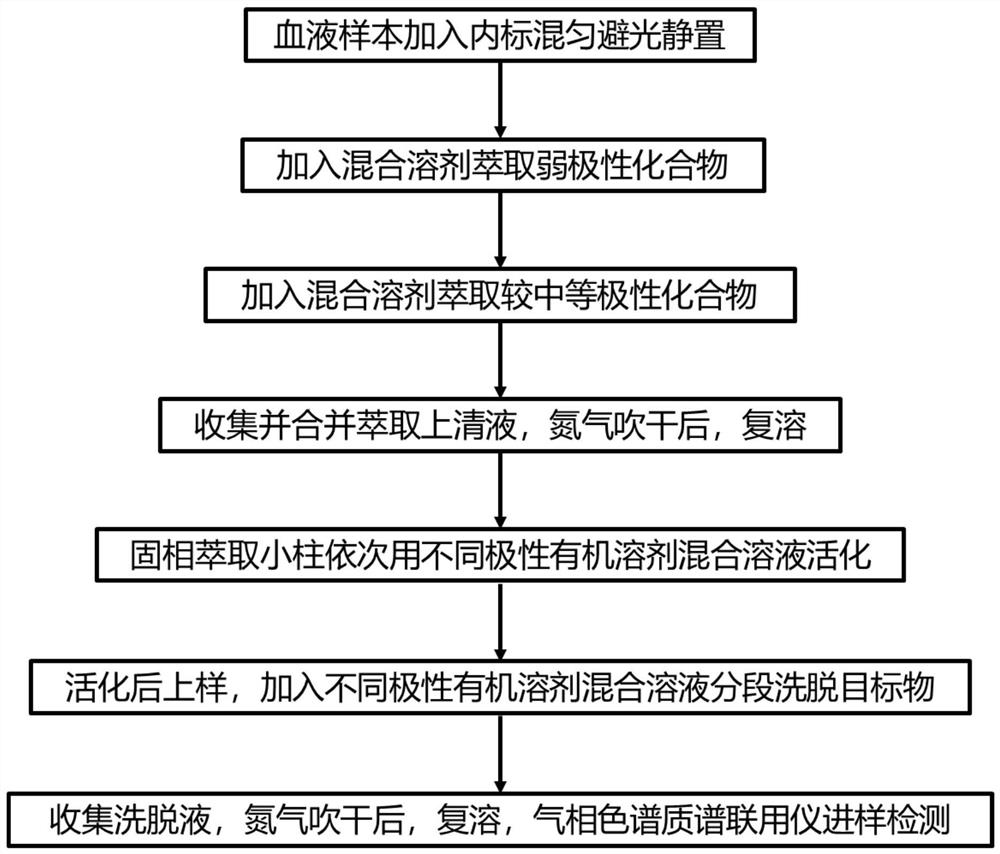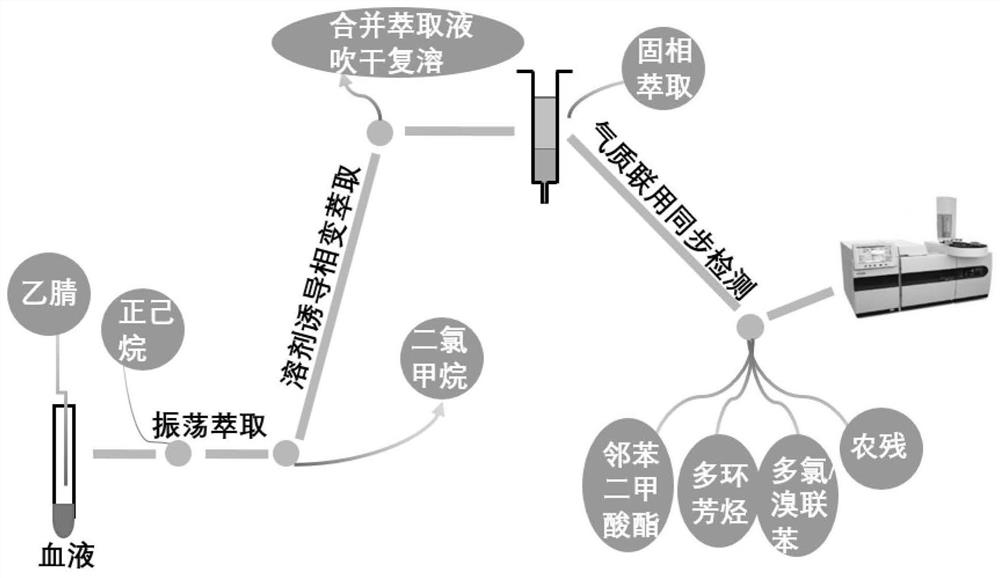Method for detecting semi-volatile organic compounds in blood
A semi-volatile and detection method technology, which is applied in the detection of 103 kinds of semi-volatile organic compounds and the detection of semi-volatile organic compounds in blood, can solve the problems of large manpower consumption of reagents, complicated processing process and long analysis time, etc. Achieve cost-effectiveness, high analytical efficiency, and reduced impurities and matrix interferences
- Summary
- Abstract
- Description
- Claims
- Application Information
AI Technical Summary
Problems solved by technology
Method used
Image
Examples
Embodiment 1
[0066] (1) Preparation of standard solution of semi-volatile organic compounds to be measured
[0067] Take an appropriate amount of each high-concentration single standard solution, and use n-hexane to prepare a single standard solution with a concentration of 10 μg / mL (7 items of phthalates, 7 items of polychlorinated biphenyls, 16 items of polycyclic aromatic hydrocarbons, polybrominated diphenyl 5 ethers), and methanol was used to prepare a single standard solution with a concentration of 10 μg / mL (68 pesticides).
[0068] (2) Optimization of chromatography / mass spectrometry conditions
[0069] Taking the use of chromatographic column DB-5MS (30*m*0.25mm*0.25μm) as an example, each 10μg / mL single standard solution is directly injected, and the full scan is performed first to find the molecular ion peak with high response and strong specificity. Parent ions (that is, molecular ions), and then set different collision energies according to pre-selected different collision en...
Embodiment 2
[0094] According to the triple quadrupole gas chromatography-mass spectrometry detection details parameter conditions set in Example 1, the whole blood of the volunteers was collected and centrifuged to obtain the serum; the serum was divided into 7 equal parts as parallel samples for the experiment. Specific steps are as follows:
[0095] (1) Multi-stage liquid-liquid extraction:
[0096] Add 0.1mL of the serum sample to be tested, add ultrapure water to dilute 2 times, add 0.5mL acetonitrile, seal the ultrasound for 5 minutes, add 1mL n-hexane, vibrate and extract for 5 minutes, take the supernatant after centrifugation, and record it as the first sample. supernatant;
[0097] Next, add 0.1 mL of dichloromethane to the above-mentioned treated serum sample again, vibrate and extract for 5 minutes, take the supernatant after centrifugation, and record it as the second supernatant;
[0098] The first supernatant and the second supernatant were combined, dried with pure nitrog...
Embodiment 3
[0116] According to the triple quadrupole gas chromatography-mass spectrometry detection details parameter condition setting determined in Example 1, another volunteer’s whole blood was collected, and the serum was obtained after centrifugation; the serum was divided into 7 equal parts as parallel samples, and the experiment was carried out . Specific steps are as follows:
[0117] (1) Multi-stage liquid-liquid extraction:
[0118] Dilute 2mL of the serum sample to be tested by adding ultrapure water to 3 times, add 2mL of acetonitrile, seal the ultrasound for 20 minutes, add 5mL of n-hexane, vibrate and extract for 5 minutes, take the supernatant after centrifugation, and record it as the first supernatant liquid;
[0119] Next, add 1mL of dichloromethane again to the above-mentioned treated serum sample, vibrate and extract for 5 minutes, take the supernatant after centrifugation, and record it as the second supernatant;
[0120] The first supernatant and the second super...
PUM
 Login to View More
Login to View More Abstract
Description
Claims
Application Information
 Login to View More
Login to View More - R&D
- Intellectual Property
- Life Sciences
- Materials
- Tech Scout
- Unparalleled Data Quality
- Higher Quality Content
- 60% Fewer Hallucinations
Browse by: Latest US Patents, China's latest patents, Technical Efficacy Thesaurus, Application Domain, Technology Topic, Popular Technical Reports.
© 2025 PatSnap. All rights reserved.Legal|Privacy policy|Modern Slavery Act Transparency Statement|Sitemap|About US| Contact US: help@patsnap.com



